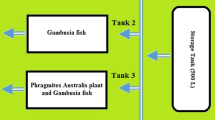Abstract
Two experimental ponds, with an effective volume of 2 m3 each, were constructed in a workshop at the textile plants to investigate the potential for a stabilization pond for purification of textile wastewater.
Parametric analysis of pH, temperature, turbidity suspended solids, total suspended solids, DO, BOD, COD, N, and algae was carried out on the influent and the effluent according to the procedures recommended by the standard methods (APHA, 1971).
Considering the results obtained from tests after daily observations, the application of an oxidation pond for treatment of textile wastewaters in the winter time was not promising. The ponds had a little activity in aerobic condition. In other seasons the ponds were efficient and the removal of BOD, COD, and N was 81, 78, 72% respectively, with a loading rate of 7.950 g BOD m−2 day−1 and detention time of 20 days. The ponds were usually saturated and sometimes super-saturated with dissolved O2.
The experimental ponds were put to work in series for BOD, COD, and N removal observation. The removal did not improve compared with a single pond and algae concentration was noticeably reduced in the effluent.
Similar content being viewed by others
References
APHA: 1971, Standard Methods for Examination of Waterand Wastewater, 13th ed., New York.
Bartsch, A. F.: 1961, J. WPCF 33, p. 239, 249.
Central Public Health Engineering Research Institute, Nagpur: 1970, Environmental Health 12, No. 1.
Echenfelder, W. W. Jr.: 1966, Industrial Water Pollution Control, McGraw-Hill Book Company, New York.
Fair, G. M., Geyer, G. C., and Okun, E. A.: 1968, Water and Wastewater Engineering, 2, p. 17, 18, 20, 26, 35. John Wiley & Sons, Inc., New York, London.
Gloyna, E. F.: 1971, Waste Stabilization Ponds, WHO, Geneva, London.
Gloyna, E. F. and Eckenfelder, W. W. Jr.: 1971, Advances in Water Quality Improvement, University of Texas Press, Austin and London.
McKinney, R. E.: 1962, Microbiology for Sanitary Engineers, McGraw-Hill Book Company, New York.
Razeghi, N.: 1971, The effects of kerosene, a larvicide, on the performance and evaporation losses of waste stabilization ponds, University of Oklahoma.
Salvato, G. A.: 1972, Environmental Engineering and Sanitation, 2nd ed., Wiley Interscience, New York.
Tajic, J. E.: 1971, Water Pollution Disposal and Reuse, 1, Marcel Dekker, Inc., New York.
Author information
Authors and Affiliations
Rights and permissions
About this article
Cite this article
Assadi, M. Application of stabilization pond for purification of textile wastewater in Esfahan, Iran. Water Air Soil Pollut 11, 247–252 (1979). https://doi.org/10.1007/BF00286636
Received:
Revised:
Issue Date:
DOI: https://doi.org/10.1007/BF00286636




